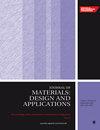Influence of workpiece geometry and natural frequencies on ultrasonic metal welding
IF 2.2
4区 材料科学
Q3 MATERIALS SCIENCE, MULTIDISCIPLINARY
Proceedings of the Institution of Mechanical Engineers, Part L: Journal of Materials: Design and Applications
Pub Date : 2024-04-16
DOI:10.1177/14644207241245431
引用次数: 0
Abstract
Ultrasonic metal welding is a well-established solid state joining process for electrical applications. The process relies on the friction between workpieces and welding tools for joint formation. This friction is generated by the process force and the ultrasonic oscillation of the welding tools imposed on the workpieces. At such high frequencies, the occurrence of resonances in actual workpiece geometries is not surprising. It is known that critical dimensions in length and width lead to nearly no bond, depending on the welding frequency and the mechanical properties of the material. In real applications, this limits the possible designs of terminals and leads to extensive testing of clamping devices. It is also known that machine learning (ML) models for quality prediction based on power signals or tool oscillation can account for changes in welding position. In this study, we investigated the impact of part resonance and antiresonance on horn and anvil oscillation, power consumption and bond strength to identify typical behaviors induced by the workpieces. The influence of material thickness and roughness was considered, and numerical analysis of the natural frequencies of the workpieces was conducted. It can be shown that the results allow a distinction between the welding positions and workpiece geometries without directly measuring the oscillation patterns of the workpieces, allowing a simple validation of geometry weldability and clamping device in applications. Furthermore, the investigation allows the knowledge based specific deduction of signal parameters for future ML models, allowing a consideration of welding position and workpieces geometry with reduced test data.工件几何形状和固有频率对超声波金属焊接的影响
超声波金属焊接是一种成熟的电气应用固态连接工艺。该工艺依靠工件和焊接工具之间的摩擦力形成接头。这种摩擦力由施加在工件上的加工力和焊接工具的超声波振荡产生。在如此高的频率下,实际工件几何形状出现共振并不奇怪。众所周知,根据焊接频率和材料的机械性能,长度和宽度的临界尺寸几乎不会产生结合。在实际应用中,这限制了端子的可能设计,并导致对夹紧装置进行大量测试。众所周知,基于功率信号或工具振荡的质量预测机器学习(ML)模型可以解释焊接位置的变化。在本研究中,我们研究了工件共振和反共振对喇叭和砧板振荡、功耗和粘接强度的影响,以确定工件诱发的典型行为。研究考虑了材料厚度和粗糙度的影响,并对工件的自然频率进行了数值分析。结果表明,无需直接测量工件的振荡模式,就能区分焊接位置和工件几何形状,从而在应用中对几何形状的可焊性和夹紧装置进行简单验证。此外,这项研究还能为未来的 ML 模型提供基于知识的特定信号参数推导,从而在减少测试数据的情况下考虑焊接位置和工件几何形状。
本文章由计算机程序翻译,如有差异,请以英文原文为准。
求助全文
约1分钟内获得全文
求助全文
来源期刊

CiteScore
4.70
自引率
8.30%
发文量
166
审稿时长
3 months
期刊介绍:
The Journal of Materials: Design and Applications covers the usage and design of materials for application in an engineering context. The materials covered include metals, ceramics, and composites, as well as engineering polymers.
"The Journal of Materials Design and Applications is dedicated to publishing papers of the highest quality, in a timely fashion, covering a variety of important areas in materials technology. The Journal''s publishers have a wealth of publishing expertise and ensure that authors are given exemplary service. Every attention is given to publishing the papers as quickly as possible. The Journal has an excellent international reputation, with a corresponding international Editorial Board from a large number of different materials areas and disciplines advising the Editor." Professor Bill Banks - University of Strathclyde, UK
This journal is a member of the Committee on Publication Ethics (COPE).
 求助内容:
求助内容: 应助结果提醒方式:
应助结果提醒方式:


